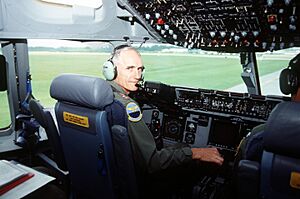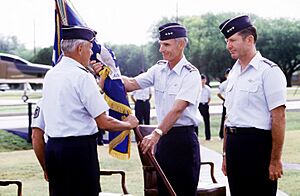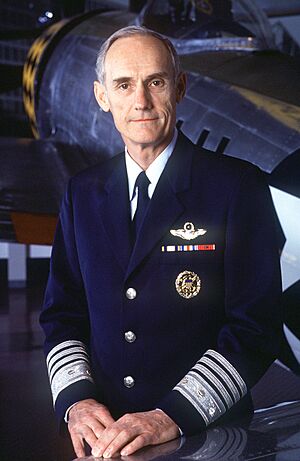Merrill McPeak facts for kids
Quick facts for kids
Merrill McPeak
|
|
|---|---|

McPeak in 1990
|
|
| United States Secretary of the Air Force | |
|
Acting
|
|
| In office July 14, 1993 – August 5, 1993 |
|
| President | Bill Clinton |
| Preceded by | Michael B. Donley (Acting) |
| Succeeded by | Sheila Widnall |
| Chief of Staff of the United States Air Force | |
| In office October 30, 1990 – October 25, 1994 |
|
| President | George H. W. Bush Bill Clinton |
| Preceded by | John M. Loh (Acting) |
| Succeeded by | Ronald R. Fogleman |
| 10th Chairman of the American Battle Monuments Commission | |
| In office July 2010 – 2018 |
|
| Preceded by | Frederick M. Franks Jr. |
| Succeeded by | David Urban |
| Personal details | |
| Born |
Merrill Anthony McPeak
January 9, 1936 Santa Rosa, California, U.S. |
| Political party | Republican (Before 2003) Independent (2003–2008) Democratic (2008–present) |
| Education | San Diego State University (BA) George Washington University (MA) |
| Military service | |
| Allegiance | United States |
| Branch/service | United States Air Force |
| Years of service | 1957–1994 |
| Rank | General |
| Commands | Chief of Staff of the United States Air Force 12th Air Force Pacific Air Forces 20th Tactical Fighter Wing |
| Battles/wars | Vietnam War |
| Awards | Defense Distinguished Service Medal Air Force Distinguished Service Medal (2) Silver Star Legion of Merit (2) Distinguished Flying Cross (2) |
Merrill Anthony McPeak (born January 9, 1936) is a retired four-star general in the United States Air Force. His most important role before he retired was serving as the 14th Chief of Staff of the Air Force from 1990 to 1994.
In 1993, General McPeak also worked as the Acting Secretary of the Air Force. He was the only Chief of Staff of the Air Force and active-duty Air Force officer to ever hold this acting position.
Contents
Early Life and Education
Merrill McPeak was born in Santa Rosa, California. After finishing high school in Grants Pass, Oregon, he went to San Diego State College. In 1957, he earned a degree in economics. He joined the Air Force as an officer in November 1957. Later, in 1974, he earned a master's degree in international relations from George Washington University.
Military Career Highlights
After his training, McPeak became a pilot, flying single-seat fighter jets like the F-100 Super Sabre and the F-104 Starfighter. He flew these planes in the United States and the United Kingdom. He also worked as an instructor pilot at Luke Air Force Base, Arizona.
Flying with the Thunderbirds
From December 1966 to December 1968, McPeak was a pilot with the Thunderbirds. This is the Air Force's special team that performs amazing flying shows. He flew in almost 200 air shows across the United States and other countries.
Service in Vietnam
After his time with the Thunderbirds, McPeak flew the F-100 fighter jet in South Vietnam. He flew many combat missions during the Vietnam War. He was part of a special group called the Misty FACs, who tried to stop supplies from moving along the Ho Chi Minh Trail. He even commanded this group for a short time. For his bravery, he received the Silver Star award. He completed 269 combat missions in Vietnam.
Later Assignments
After Vietnam, McPeak continued to serve in many important roles.
- From 1970 to 1973, he worked at the Air Force Headquarters in Washington, D.C..
- He commanded the 513th Combat Support Group in the United Kingdom starting in 1976.
- He also commanded the 20th Tactical Fighter Wing in the United Kingdom, flying the F-111E fighter bomber.
- He became the commander of the 12th Air Force and Air Forces for United States Southern Command in 1987.
- A year later, he was named commander-in-chief of Pacific Air Forces (PACAF).
Air Force Chief of Staff

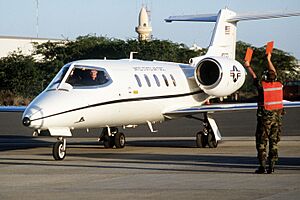
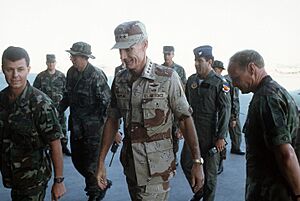
General McPeak became the Air Force Chief of Staff in October 1990, appointed by President George H. W. Bush. He took on this role during Operation Desert Shield and helped plan the strategy for Operation Desert Storm.
After the Gulf War, the Air Force became smaller due to the end of the Cold War. During his time as Chief of Staff, McPeak oversaw big changes. He combined many different Air Force commands into new, larger ones. For example, he helped create the Air Combat Command (ACC) and Air Mobility Command (AMC).
McPeak also made major changes to the Air Force's organization. He wanted to make the Air Force more focused on combat and readiness. He also introduced a new design for the Air Force's service dress uniform. This new uniform looked different from the older one, which was similar to the Army's. Some parts of his uniform design were later changed back by the next Chief of Staff.
In 1993, McPeak also served as the Acting Secretary of the Air Force for three weeks. He was the only person to hold both the Chief of Staff and Acting Secretary roles at the same time. He retired from the Air Force in October 1994.

After His Military Career
After retiring from the Air Force, General McPeak worked as a consultant and business executive. He served on the boards of directors for several companies, including TWA and Tektronix. He was also a founding investor and chairman of Ethicspoint, a software company.
In July 2010, McPeak was appointed to the American Battle Monuments Commission. This commission is responsible for maintaining U.S. military cemeteries and memorials overseas. He was the tenth Chairman of this commission and the first Air Force officer to lead it. In 2018, France honored McPeak with the Legion of Honor award for his service and his work with the commission. He helped restore the Lafayette Escadrille Memorial near Paris.
General McPeak also wrote three books about his time in the Air Force, called "The Aerial View Trilogy." The first book, Hangar Flying, was published in May 2012. The second, Below the Zone, came out in November 2013, and the third, Roles and Missions, in January 2017.
Awards and Recognition
- In 1992, San Diego State University gave General McPeak its first-ever Lifetime Achievement Award.
- In 1995, George Washington University honored him with its Distinguished Alumni Award.
- He was also inducted into the Sigma Chi Fraternity Hall of Fame.
- He is one of the first people to be inducted into the Oregon Aviation Hall of Honor.
Political Activities
General McPeak has been involved in politics after his military career. In 1996, he led Bob Dole's presidential campaign in Oregon. In the 2000 U.S. presidential election, he supported George W. Bush. However, he later disagreed with some of the Bush administration's policies, especially the 2003 invasion of Iraq.
He then supported Howard Dean's presidential campaign and later advised John Kerry's campaign. He was also a co-chair for Barack Obama's 2008 presidential campaign.
Dates of Rank
| Insignia | Rank | Date |
|---|---|---|
| Gen | Aug. 1, 1988 | |
| Lt Gen | May 22, 1985 | |
| Maj Gen | Oct. 1, 1983 | |
| Brig Gen | July 1, 1981 | |
| Col | April 1, 1974 | |
| Lt Col | Nov. 1, 1972 | |
| Maj | May 20, 1968 | |
| Capt | Oct. 1, 1962 | |
| 1st Lt | May 30, 1959 | |
| 2nd Lt | June 19, 1957 |
Awards and Decorations
McPeak received many military awards and decorations, including:
 Office of the Joint Chiefs of Staff Identification Badge Office of the Joint Chiefs of Staff Identification Badge |
| Air Force Distinguished Service Medal with oak leaf cluster |
| Legion of Merit with oak leaf cluster |
| Distinguished Flying Cross with oak leaf cluster |
| Air Medal (13 olc) |
| Air Force Commendation Medal (3 olc) |
| National Defense Service Medal with star |
| Vietnam Service Medal with 4 service stars |
| Air Force Overseas Service Ribbon Long Tour with 2 oak leaves |
| Air Force Longevity Service Award (1 silver olc and 3 bronze olc) |


